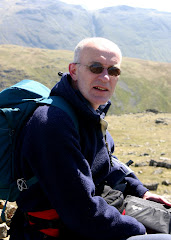This is the longest day of all 11 with a length of 23 miles, some of which is hard work. It may be that you wish to break this day at Rookhope which will reduce the day to 18 miles, adding the five miles to the next day's walk to Hexham (at only 10 miles this is very possible but does mean that there will have been a deviation from Wainwright's original).
Day 4 starts by finding the old railway line at the nicely converted station buildings at Romaldkirk station and heading up the valley towards Mickleham. Wainwight again followed the road (not having the chance to walk along the railway which was still in operation pre-Beecham). Details of the railway would be interesting.

The route continues on the track bed to what was the end of the line at the station near Middleton, although in 1938 there was the mining line running further up the valley that Wainwright so disliked in his continuing diatribe about how Teesdale had been spoiled by human activity. Middleton had grown up on the back of the lead mining and the area is scarred with evidence of the industry. Information about the mining would be very useful such as when the last activity ceased.
The new route doesn't venture into Middleton but joins, again, the Pennine Way route proceeding up the valley on the south side of the Tees.

Following to the south of the river the new route crosses the Tees and leaves the Pennine Way as it proceeds along Teesdale towards High Force. At a footbridge the route turns northwards heading for the hills at Swinhope Head and joins a minor road at Broadley's Gate. Local detail of the Tees valley would be useful here.
 Although it may be possible to cross Newbiggin Common via paths the route joins with Wainwright's simply because today is a long walk and the quiet road allows for steady progress on this very long day. As the road is joined the site of Flushimere House can be seen on the right which in 1998 was derelict. I wondered then as to the history of the property and assumed that its presence was associated with the lead mining. Information about the house would be interesting for there are not many other notable points on this leg of the trek.
Although it may be possible to cross Newbiggin Common via paths the route joins with Wainwright's simply because today is a long walk and the quiet road allows for steady progress on this very long day. As the road is joined the site of Flushimere House can be seen on the right which in 1998 was derelict. I wondered then as to the history of the property and assumed that its presence was associated with the lead mining. Information about the house would be interesting for there are not many other notable points on this leg of the trek.
Wainwright's view of Teesdale had been less than kind and he was even more critical of Weardale which is reached having descended from Swinhope at the village of Westgate. Walking under yet another disused railway I would like to find something positive to redress the balance (although I have to say that I recall an unattractive village with little to commend it).


Passing through the general detritus of old workings it is hard to imagine that Blanchland had been the location of the London Lead company until they moved their northern base to Middleton. Blanchland itself is an unreal place that is as delightful as it is unusual. Accommodation in the village is hard to come by with the Lord Crewe Arms being the only hostelry and, I suspect, likely to be beyond most walkers' budget for overnight accommodation but a fascinating place to eat and drink.

Day 4 then is over (or day 5 has begun if you have decided to break the day at Rookhope) and for the whole day the walker is surrounded by evidence of man's past-misdemeanours and his wholesale vandalism of his environment in the search for profit.


No comments:
Post a Comment